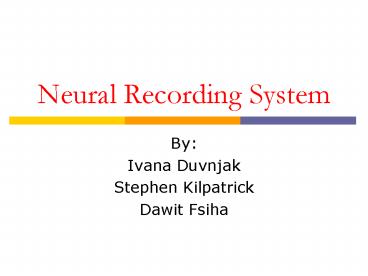Neural Recording System PowerPoint PPT Presentation
Title: Neural Recording System
1
Neural Recording System
- By
- Ivana Duvnjak
- Stephen Kilpatrick
- Dawit Fsiha
2
Outline
- What is a Neural Network Recording System?
- Why are they important?
- How can they be improved?
- Some possible solutions
- Analysis of some solutions
- Conclusions
3
Neural Network Recoding Systems
- Brain sends electrical signals - Neurons
- Sent through axons
- Electrical Signals processed by synapses
- Mapping the brain
4
Applications
- Medical Research
- Mental Performance
- Mental Illness
- Sleep Disorders
- Etc.
5
Subsystems
- Electrode
- Amplifier
- Multiplexer
- Transmitter
- Receiver
6
Block Diagram of System
MUX
7
Possible Improvements
- Areas to improve in the neural recording system
- Electrodes
- Amplifier
- Multiplexer
- Transmitter
- Receiver
8
Neural LNA Amplifier
- Functions
- Power dissipation must kept low
- Must reject noise ( flicker noise)
- Amplifying a weak signal received from the
electrodes - Must reject the DC offset created at the
electrodes-Tissue interface
9
Neural Amplifier Requirements
- Power dissipation
- Bandwidth requirement
- Gain
- Stability
- Overall size
10
Amplifier Solutions Design I
OTA Design
Neural Amplifier Circuit
11
Amplifier Solutions Design II
Neural Amplifier Circuit
OTA Design
12
Design I Simulation Results
- 10 pW power consumption
- 39.974dB gain
- Low-cutoff frequency 0.4Hz
- High-cutoff frequency 7.852kHz
- Area 0.16mm2
- Stable
13
Design II Simulation Results
- 11.5 pW power consumption
- 40.362dB gain
- Low-cutoff frequency 83.114Hz
- High-cutoff frequency 32.526kHz
- Area 0.091mm2
- Stable
14
Comparison of Designs
Table 1. Summary of simulation results for the
neural amplifiers
Parameter Expected Circuit 1 Simulation Circuit 2 Simulation
Supply voltage /-2.5V /-2.5V /-1.5V
Power dissipated lt5mW 10pW 11.5pW
Gain 40dB 39.974dB 40.362dB
Bandwidth 7.0kHz 7.852kHz 32.443kHz
Low-frequency cutoff 0.025Hz 0.4Hz 83.144Hz
High-frequency cutoff 7.0kHz 7.852kHz 32.526kHz
15
Conclusions
- Both designs meet the requirements of
- Power consumption
- Stability
- Size
- DC offset rejection
- Design I is significantly better, due to the more
desirable bandwidth requirements.
16
Implementation
17
References
18
Exit(0)
- Questions?
PowerShow.com is a leading presentation sharing website. It has millions of presentations already uploaded and available with 1,000s more being uploaded by its users every day. Whatever your area of interest, here you’ll be able to find and view presentations you’ll love and possibly download. And, best of all, it is completely free and easy to use.
You might even have a presentation you’d like to share with others. If so, just upload it to PowerShow.com. We’ll convert it to an HTML5 slideshow that includes all the media types you’ve already added: audio, video, music, pictures, animations and transition effects. Then you can share it with your target audience as well as PowerShow.com’s millions of monthly visitors. And, again, it’s all free.
About the Developers
PowerShow.com is brought to you by CrystalGraphics, the award-winning developer and market-leading publisher of rich-media enhancement products for presentations. Our product offerings include millions of PowerPoint templates, diagrams, animated 3D characters and more.

